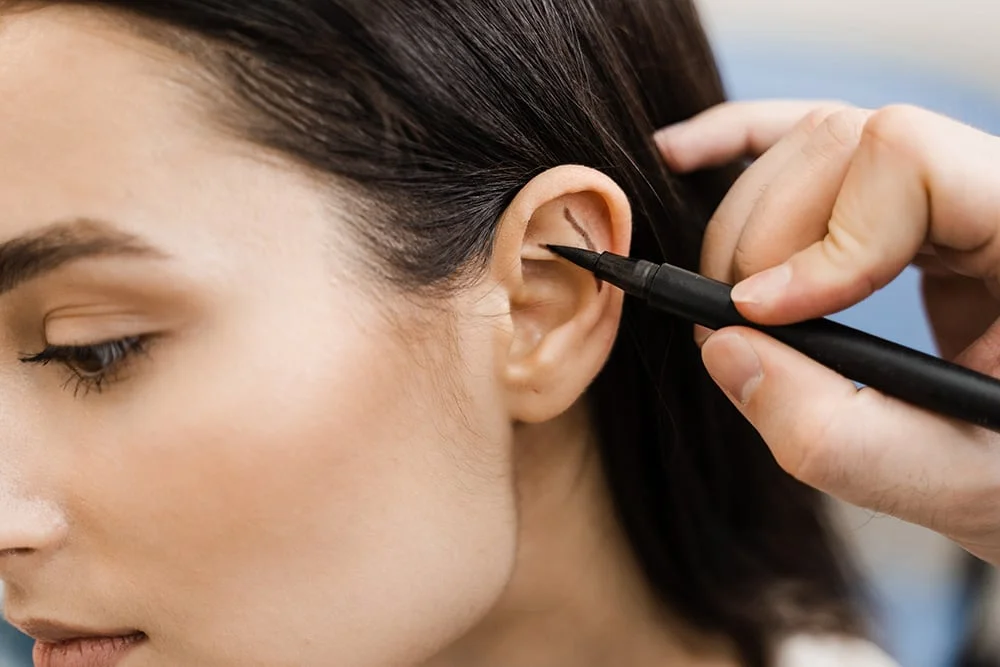Otoplasty
Otoplasty is a facial plastic surgery procedure designed to enhance the appearance of the ears. Often, patients who may desire otoplasty are children with large protruding ears, however adults who are bothered by their ear position and contour may also undergo otoplasty. Otoplasty is more than simply “pinning” the ears back. Precise suturing of the ears is essential to gain the contours often missing in protruding ears, and exact removal of cartilage can be necessary to achieve symmetry and maintain a natural position and shape to the ears.

“I cannot say enough GOOD things about my experience with Dr. Shadfar. His entire staff was very professional and friendly and took wonderful care of me. Dr. Shadfar's skill as a surgeon is unmatched in my opinion.”
The Recovery
The morning after surgery, board-certified facial plastic surgeon Scott Shadfar, MD will see the patient in clinic and check all incisions, remove the head wrap, and go over all wound care measures. Swelling and bruising can be seen, however only mild pain or soreness is associated with otoplasty. The sutures are removed on the seventh day after surgery, and an elastic headband is worn at all times over the ears for the next week. During the next month, the headband is only worn at night to protect the ears while sleeping. Patients usually have minimal downtime of 1-2 weeks before returning to work, and we ask those patients traveling from out-of-town to stay for routine checks during the first week.
Will Scars From Otoplasty Be Visible?
Dr. Shadfar takes care to place incisions discreetly behind the natural contours of the ears, so there should be no post-operative scarring visible to outside observers. Incisions for otoplasty generally heal very well, allowing scars to lighten and fade nicely over time. To further minimize signs of surgery, Dr. Shadfar can also recommend high-quality skincare products and lightening creams that may help diminish the appearance of your scars. Other ways to prevent scars from darkening include using sun protection whenever outdoors (hats, sunscreen, etc.) and closely adhering to Dr. Shadfar’s wound care instructions during the healing period.
Otoplasty Frequently Asked Questions (FAQS)
Am I A Good Candidate For Otoplasty?
Candidates for otoplasty typically have prominent ears that protrude far from the head. Newborn children often grow up with protruding ears if the ears are more than 9mm from the sides of the head. Adults who have the upper portion of the ears protruding more than 20mm from the sides of the head are often ideal candidates for otoplasty.
Some people are also born with an irregular shape to the ears, often characterized by conditions such as a constricted or cupped ear, Stahl’s ear, lidding ear, missing antihelical folds, or enlarged conchal bowls. Ear abnormalities occur in approximately 5% of children. Doctors typically encourage parents to wait until their child is at least five years old before choosing to undergo ear surgery because the ears should be at least 90% fully grown by that time; however, otoplasty can be performed for patients of any age.
What Are The Benefits Of Ear Surgery?
The advantages of ear surgery can be essential in boosting one’s self-esteem on top of the aesthetic enhancements. Some of the potential benefits of otoplasty include:
- Repositioned ears closer to the head
- Reshaped ears for a more balanced, symmetrical appearance
- Reduced overall size of the ears
- Enhanced facial harmony
- Improved confidence and self-esteem
Young children may feel particularly uncomfortable with the appearance of their ears. The cosmetic effects of otoplasty early in life can be very helpful in avoiding embarrassment or self-consciousness during school and other social activities.
Is Surgery Necessary?
Otoplasty is considered an elective surgery, as there are no health concerns associated with prominent or irregularly-shaped ears. Unfortunately, many children with ear abnormalities experience teasing and embarrassment from their peers. In some cases, the psychological ramifications of these childhood experiences may lead to poor academic performance, social anxiety, or aggressive behavior. Otoplasty surgery is one way to address a variety of concerns with long-lasting, often permanent results.
Is Otoplasty Painful?
Dr. Shadfar uses the latest surgical technology and techniques to conduct each surgery as safely and efficiently as possible, prioritizing the comfort of the patient. For about a week after the procedure, soreness is common. Over-the-counter pain medication can be used to manage any discomfort.
Are Both Ears Addressed During Otoplasty?
Yes, both ears are usually treated during an otoplasty procedure — even if only one ear protrudes outward. Although each patient’s needs will be assessed individually, addressing both ears is often the best way to achieve a proportionate outcome. In most cases, comprehensively performing otoplasty can foster a greater sense of facial balance and allow the final outcome to appear natural and more symmetrical. Dr. Shadfar will discuss the best approach to your ear correction during your consultation.
Is Otoplasty Covered By Insurance?
Most medical insurance policies do not cover otoplasty since the elective procedure is typically performed for cosmetic purposes.
How Do I Sleep After Otoplasty?
It’s generally recommended to sleep with the head elevated for the first couple of weeks after your procedure, as this positioning can reduce swelling and better facilitate the healing process. Propping up pillows behind the head is usually sufficient enough to achieve an angle of slight elevation while asleep. An elastic headband will also be worn at night to ensure your incisions are not irritated, stretched, or otherwise disturbed.
How Long Will The Ears Take To Heal?
Most swelling should subside within the first couple of months after your surgery, although residual swelling can last up to six months. Every patient has a unique rate of healing but most individuals see improvements in their ear shape at approximately two to three weeks into their recovery.






